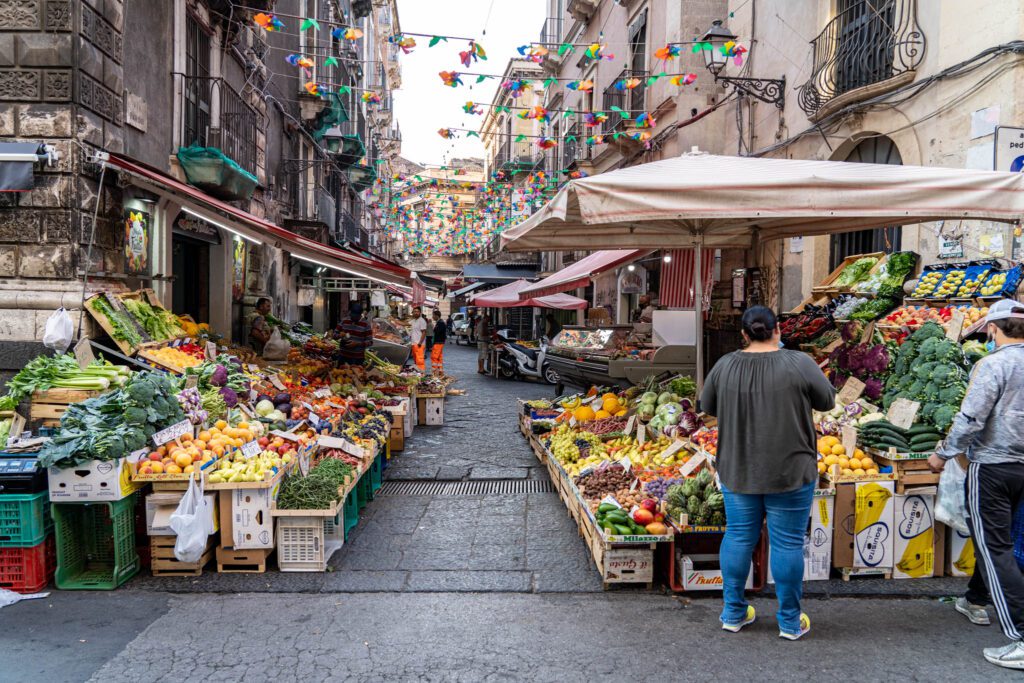The Best Things to Do in Catania in One Day
Wondering what the best things to do in Catania are? Or maybe you’re trying to figure out whether or not you should spend any time in Catania while you’re in Sicily. Either way, you’re in the right place. In this guide, we’re going to try to convince you that you should spend a day in Catania (or more), and give you our take on what to do in Catania based on our own experience.
Can I be perfectly honest with you for a second? Before we started researching for our Sicily road trip, I truly had no idea that Catania exists.
I knew Palermo, Siracusa, and Mount Etna, but I would not have been able to tell you where Catania was on a map, or even whether it was on Sicily or on mainland Italy. Somehow, Sicily’s second biggest city flies well under the radar when it comes to tourists, at least from the United States.
But after spending five nights in Catania, I can honestly say that it blew away my expectations. It’s not flashy – there’s really no major tourist sights to speak of. But there are two things that we think make it a special place to visit.
First is the proximity to other places in eastern Sicily – namely Taormina and Mount Etna – that make it a perfect home base for people exploring southeastern Sicily without a car. Even Syracuse is an easy day trip away, though we’d recommend spending a night or two down there if you have the time.
The second thing that makes it special is the sheer amount of history within the city limits. It should be noted that basically the entire island is an incredible display of history, but Catania was our introduction to the island that has been shaped by natural disasters and, frankly, war, for thousands of years, and it was a great introduction.
We’ll get deeper into Catania’s history below, but we were continuously flabbergasted at the fact that, for thousands of years, the city was just continuously rebuilt on top of a base of older buildings. As a result, you’ve got modern buildings built on top of Roman amphitheaters built on top of a Greek Acropolis.
Coming from America, where most cities were planned meticulously starting just a few hundred years ago, it’s crazy to me to think that Catania is a city built upon a city built upon another city, all hundreds and hundreds (even thousands) of years old.
We know, there are just so many amazing places to visit in Sicily, which means Catania usually ends up being one of the first places that gets cut when you’re planning your trip.
But we hope this guide inspires you to spend a night or two in the city itself, rather than using it as a home base for exploring other parts of the island or simply flying in and immediately leaving.
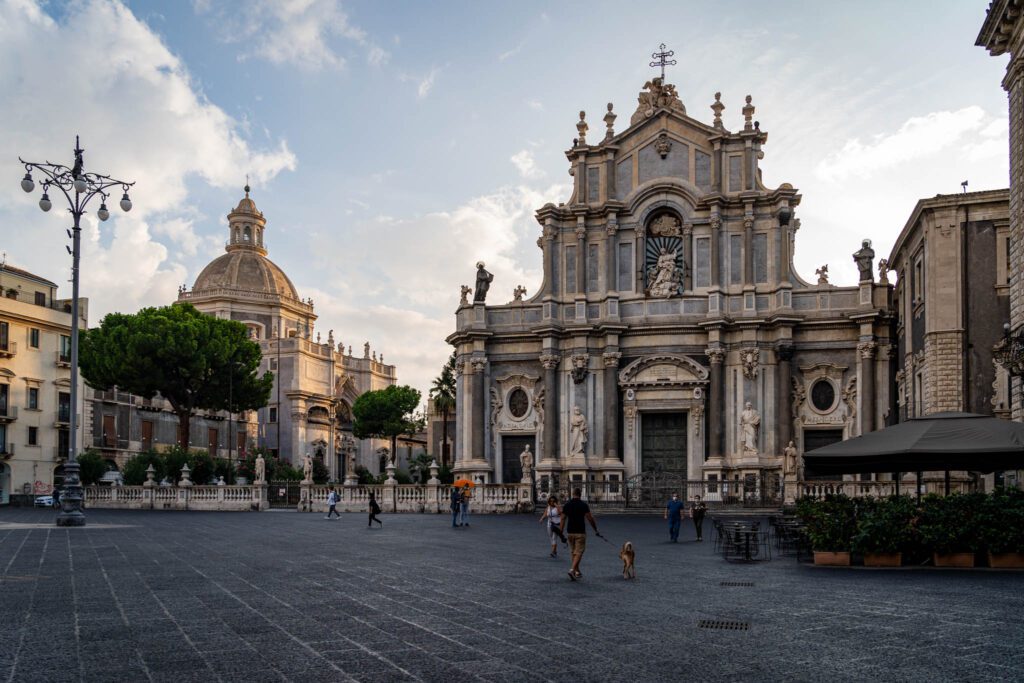
Disclaimer: Some of the links in this post, like hotel links, are affiliate links, meaning at no additional cost to you, we make a little bit of money if you click through and book. That being said, we would never recommend something to you that we don’t stand behind 100%.
What to Do in Catania: The Best Things to Do in Catania, Italy
We’ll jump right into it. Here are our picks for the best things to do in Catania, roughly organized in the order of how we would recommend focusing your time.
Tour the Monastero dei Benedettini di San Nicolò l’Arena

This was our favorite thing we did in Catania, and it’s something that we usually wouldn’t gravitate towards. However, in this case, we think the guided tour of the Benedictine Monastery – one of the biggest in Europe – is a must-do in Catania.
Again, it’s worth saying that this is a little out of character for us. But we were amazed at how much we enjoyed the hour-long guided tour, which is not just focused on the monastery itself, but digs deep into the history of the city since the 16th Century.
I don’t think I would bother visiting if you don’t do the guided tour, because the part we liked was the history lesson from our guide about the monastery and the city of Catania. The tour was amazing.
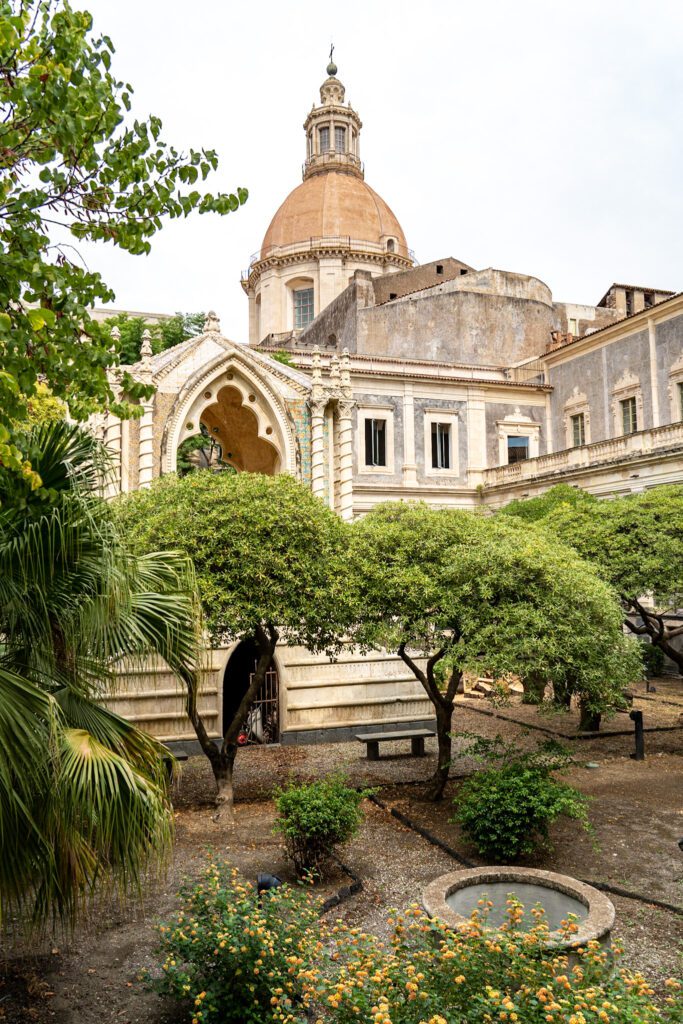
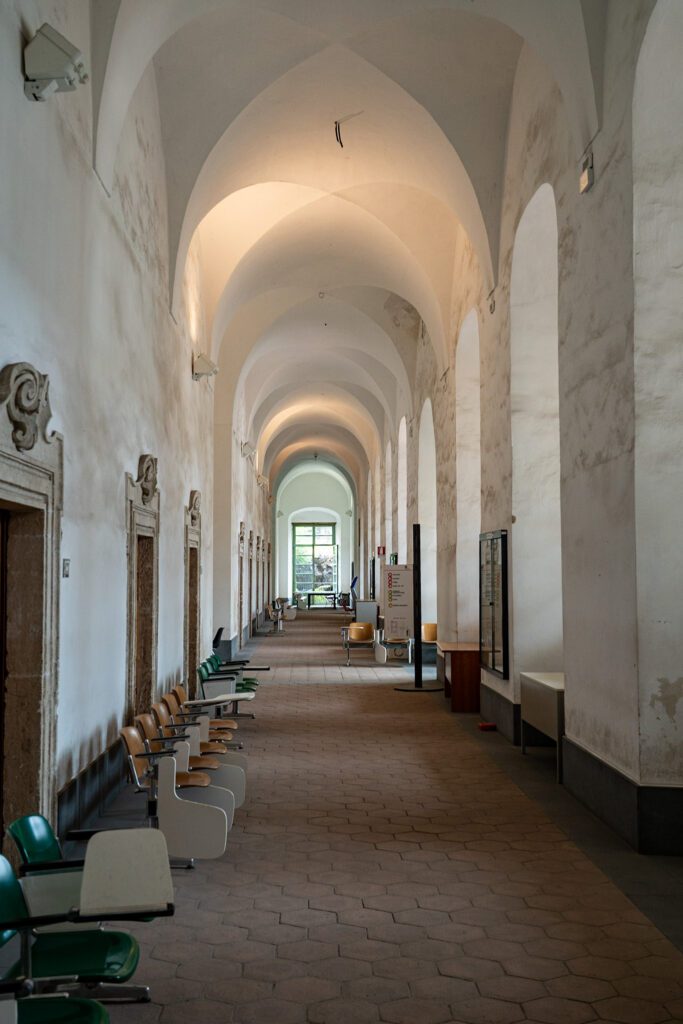
This is a former Benedictine Monastery that is the second largest Benedictine Monastery in Europe. I say “former” because in the 19th Century around the time of the unification of Italy, it was confiscated by the government and transformed into a public building that housed a school and a hospital, among other things, and basically destroyed the monastery in the name of pragmatism.
Today, it belongs to the University of Catania, which has done their best to restore it to its former glory.
But, as we learned, that’s not the only time the monastery has been destroyed. It was built in the 16th Century – though at that time it was much smaller than it is today – and promptly was damaged twice in the span of 24 years with the eruption of Mount Etna in 1669 and the 7.4 magnitude earthquake that rocked Sicily’s eastern coast in 1693.
This is where I think the tour serves as an incredible introduction (and history lesson) to Catania. The monastery is a good allegory for the city of Catania as a whole.
Built on top of a hill where remains from the Neolithic era have been found, the area around the monastery has served as the site of a Greek acropolis, the center of a Roman city, and plenty more. However, it also serves as a reminder of the natural disasters that have affected Sicily over the past several centuries, and how they have shaped the city as we know it today.
For example, the second part of the monastery – which was added over 150 years starting in 1702 – was built on top of the lava flow that completely transformed the city when Etna erupted in 1669. The second part of the monastery, as you’ll see on the tour, was built ON TOP of the lava flow, which added 2.5 meters to the height of the ground around the original monastery so that the ground floor of that original portion is now underground.
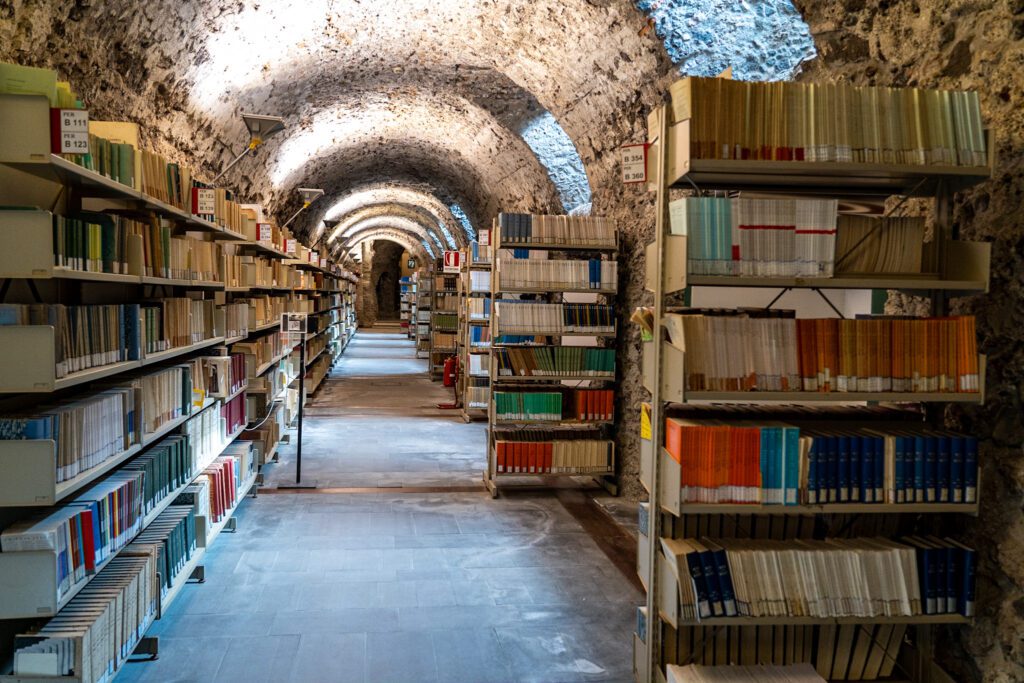
The other part of the history of Catania that is illustrated by the monastery is the fact that the entire city is built on top of old ruins from Roman and Greek times. Excavations revealed an old Roman house below the ground floor of the monastery, which is a common theme at all of the sights (we’ll get to more of them below).
Anyway, I think the tour is well worth the 8 Euros per person you’ll pay for it. We really enjoyed it, and think you will too. There are tours in both Italian and English, and at the time of our visit you had to make a reservation in advance.
Check their website here for updated information.
Discover the Teatro Romano di Catania
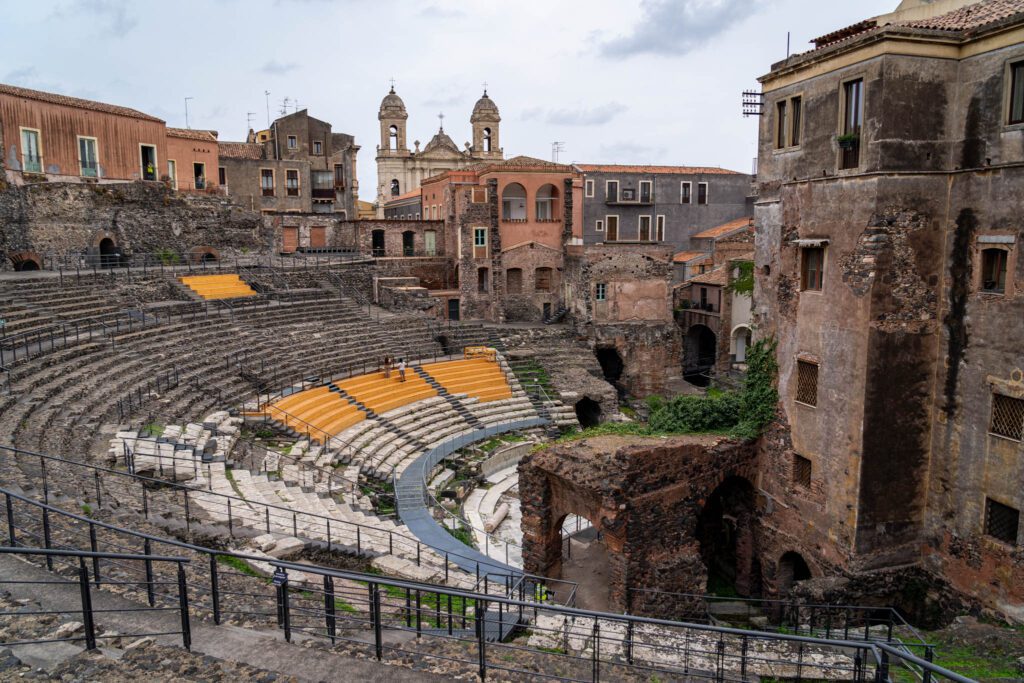
For clarity’s sake, there are two Roman theaters that you can visit in Catania. This one is near Piazza del Duomo, and is the larger and more excavated of the two. It is estimated to have been built in the 2nd Century CE, and it was fully excavated in the 19th Century.
It’s another example of the nature of Catania and all the history that lies beneath its modern streets, which have been rebuilt several times on top of lava flows that have covered entire portions of the previous city. Essentially, Catania is a city on top of a city on top of another city. And the theater is one of the better examples of that idea.

You can visit the theater, and the signage and narrative are okay – many of the signs are translated fairly poorly, to the point where Alysha and I would stand there and try to piece together what they were trying to say. It’s like they used Google Translate, which is good for getting broad ideas across, but bad for the level of detail required for this particular use case.
The most impressive part is the theater itself. It’s definitely worth a visit, but you’ll see a better example (with a better view, for sure) if you make it up to Taormina.
The museum costs 6 Euros. At the time of our visit, you had to register ahead of time to visit. Check updated information at their website here.
Roman Amphitheater of Catania

Not to be confused with the previous one, this one is a quick 5-10 minute visit, where you’ll be able to admire the Roman ruins that are, quite literally, in the middle of one of the busiest parts of the modern city of Catania.
One of my favorite parts about visiting Italy, in particular, is the fact that it is so clear that some of the buildings and ruins here are really, really, old. In this case, you’re walking down Via Etnea, one of the busiest and most modern feeling streets in Catania, and oh, hey, there are some ruins right over there to the left. Let’s go check those out.
This theater is thought to have been built in the 2nd Century CE, and is yet another example of how Catania is a city on top of a city on top of another city.
Only a tiny portion is visible now, but it’ll make you do a double take at the contrast between these ruins, which are centuries old, and the chaos of cars zooming by and modern buildings rising up behind them.
Delve into the World of Granita
Alysha is a gelato fiend. “A gelato a day keeps the doctor away” is basically her motto, at least while we’re in Italy. In Catania, our first stop on our Sicily road trip, we discovered a new, beautiful, equally tasty ice cream alternative: granita!
Granita is basically ice cream without the cream – learn more about granita here.
It’s a mix of ice, sugar, and ingredients for flavor that are formed into a sorbet-esque treat. You can find all sorts of flavors, depending on the season, from berries in the summer to pistachios in the fall. Our consistent favorites were almond and pistachio.


We found that the texture in Catania was the best of the many places we tried granita. It’s more creamy and gelato-like (though not quite as creamy) in Catania, whereas in other cities like Noto, it was noticeably more icy, for lack of a better way to describe it.
One of our favorite things we learned about granita is that you can’t serve it in a cone because it melts too fast, especially in the summer heat. So, instead, it’s served alongside a piece of brioche, which you can dunk in the melting granita for a delicious…*checks notes*… breakfast?
Yeah, that’s right. Granita and brioche, particularly coffee granita, is a breakfast item in Sicily.
We tried several different places to find the best granita in Catania, and landed on Caffetteria Villaroel (here it is on Google Maps) and their pistachio as our absolute favorite granita in Catania.
We’d advise skipping the places on Piazza del Duomo, which were, uh, not great, to say the least. Believe us, we tried it. You know, for science.
Take a Day Trip to Mount Etna

The history of Catania – and much of eastern Sicily, really – is intertwined with the history of Mount Etna. The volcanic activity from Etna has shaped the city over the millenia that it has existed, and without it, Catania and the rest of Sicily would not have the fertile volcanic soil that has proved to be an incredible asset for growing all sorts of produce.
Mount Etna is an active volcano – one of the most active in the world – that sits just north of Catania at the northeast corner of the island of Sicily. The current summit – we’ll get to why I used the word “current” in a second – sits at 3,357 meters above sea level, making it the tallest mountain in Italy south of the Alps (which blew our minds).
It’s the second largest active volcano in Europe, surpassed only by Mount Teide on Tenerife. It also happens to be a UNESCO World Heritage Site as of relatively recently.
I say “current summit” because everytime Etna erupts, lava comes out and raises the summit by as little as a couple of meters, or as much as tens of meters, depending on the eruption. And our guide told us that it has erupted no less than 56 times this year alone (2021).
Etna is an active volcano, though, as multiple locals we interacted with put it, it’s not the “boom boom lava everywhere” kind of eruption you see in the movies. Instead, because there’s a high concentration of silica – that’s glass – in the lava, it slowly rolls down the slopes of the volcano, which gives people plenty of time to get out of it’s path (though it still destroys everything in its path).
The city walls largely prevented much damage and destruction to the city, but a visit to the Benedictine Monastery – which was a part of the city that the lava reached and buried a part of the ground floor two and a half meters under the lava – will show you how lava impacted the city.
Want a fact that will blow your mind? The eruption in 1669 moved Catania’s coastline 2km further out into the sea. TWO KILOMETERS. That’s wild, y’all.
Anyway, we think a visit to Mount Etna is essentially a must-do when you’re in Catania, and there are only a couple of ways to do it. They are:
- Go all the way up to the summit of Etna, which is only accessible via guided group tour that leaves from Etna South – aka Rifugio Sapienza.
- Go to “Etna South” and visit the area on your own, independently.
- Take a guided tour that includes transportation from Catania, but DOES NOT go to the summit.
Visiting the Summit of Mount Etna
The summit of Mount Etna is only accessible with a guided tour for fairly obvious reasons. Poking around the summit of a notoriously unpredictable active volcano is not exactly a safe place to be, and having an expert guide very well could save your life.
Unfortunately, the summit tours of Mount Etna (like this one, which was on our list) leave from Rifugio Sapienza at 9:00 am sharp. It’s about an hour, maybe a bit more, from Catania if you’re driving yourself, which makes it perfectly accessible if you have rented a car.
Unfortunately for us, we didn’t rent a car until after leaving Catania, so we weren’t able to make it up to the summit despite being avid hikers.
If you want to head up to the summit, you’ll need to rent a car, book a guided tour, and be ready to go at 9:00 am.
Visiting Mount Etna Without a Car from Catania
If you don’t have a car while you’re in Catania like us, there are several tour options that pick you up in Catania and head up to Etna, but it’s important to note that none of them involve a visit to the summit.
We did this tour with Marco, a Catania native, and really enjoyed it because it takes you on a short hike to see the southeastern crater and lava flows in the Bove Valley. We saw only a handful of people on that hike, compared with the crowds we saw at Rifugio Sapienza when we arrived later in the day.
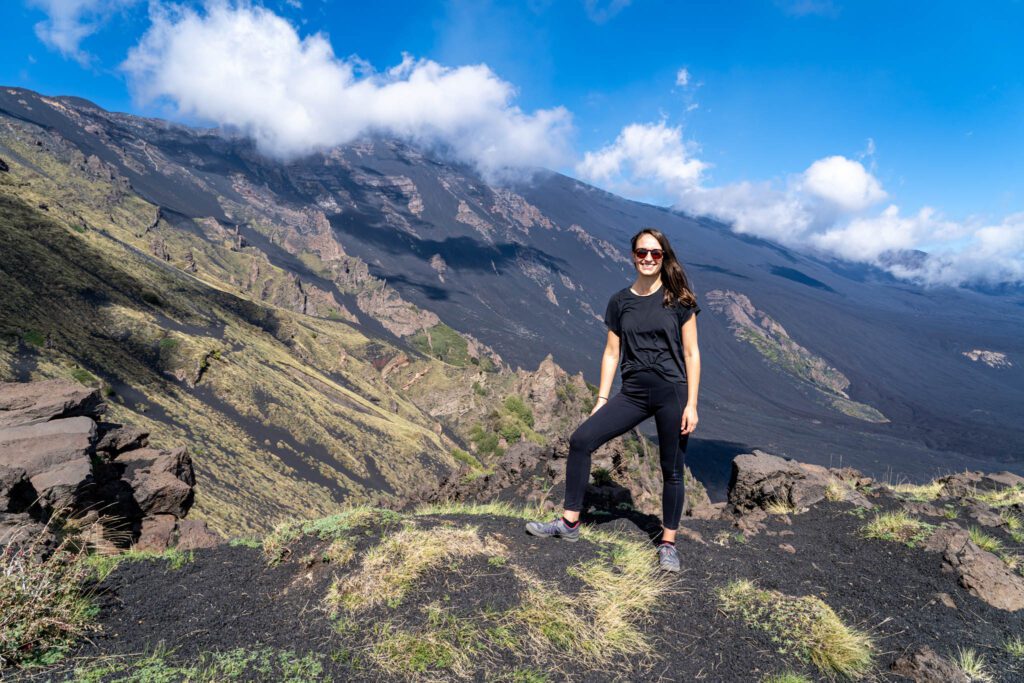
There are a bunch of similar tours out there that include some form of hiking. We chose this particular one because they provide footwear, trekking poles, and other equipment you might need.
Here are three alternatives that are fairly similar to the one we did.
- Discover Etna With an Adventurer
- Catania: Mount Etna Trek and Cave Tour
- Catania: Mount Etna Morning or Sunset Day Trip with Tasting
Visiting Etna Independently
You can also visit Etna independently. To get there, you’d either take the public bus from Catania to Rifugio Sapienza or drive yourself if you have a car.
From there, you can take the cable car / gondola up the mountain (it’s 30 Euros per person for a roundtrip ticket), or hike up yourself from the base of the gondola, which involves a completely exposed 900m climb that we, a pair of avid hikers who have done plenty of 10+ mile hikes in the past year, would probably not do.
At the top of the cable car, you can hike out to Torre Del Filosofo and around one of the craters formed by a recent eruption, where you’ll be at 2,900 meters above sea level.
Again, it’s worth noting that you cannot visit the summit without a guided tour, so 2,900 meters is as high as you’ll be able to go on your own.
Visit the Hilltop Town of Taormina

The charming hilltop city of Taormina is another easy day trip from Catania, and one that we personally did and enjoyed. And I say that despite the fact that we did the 20 minute walk from the train station to the city in the middle of a torrential downpour and thunderstorm.
Lucky for us, a nice Italian gentleman came out for a smoke break and rescued us from our perch underneath a single roof panel next to a hotel’s dumpsters and let us wait out the worst of the rain inside.
One tip for Taormina: go as early as you can. We got there around 9:00 am, and it was empty. We had the theater largely to ourselves. By the time we left the theater around 11:00 am, it was packed. Wall-to-wall people along Taormina’s main street. The earlier, the better, we think.
To get there, you have a couple of options.
- By Bus: The bus is heralded as the much more convenient option by guidebooks and locals alike, but we had trouble finding information on it (like where to pick it up from), so we opted for the train. Interbus is the best bus company we came across, and has a route that goes directly from Catania (specifically, here) up to Taormina, takes an hour and ten minutes, and costs 5.50 Euros per person, one way. Buses leave every hour for most of the day, with a small gap during the afternoon.
- By Train: Catch the train from Catania Centrale (via Trenitalia), which takes you up the east coast of Sicily to Taormina-Giardini. However, it’s worth noting that the train station is actually at the bottom of the hill, and to get to Taormina proper you have to either walk uphill for 20 minutes (which is what we did, in the pouring rain), or take a connector bus from the train station up the hill (1.90 Euros each way). You can get a combined ticket for the train and connector bus by searching for tickets from Catania to Taormina Centro, which is much closer to the center of town.
Once you’re in Taormina, there are three things that you definitely shouldn’t miss. These aren’t, by any means, the only things you should do. But we do think you should prioritize them, if you can.

- Teatro Antico di Taormina: The Greco-Roman amphitheater in Taormina is really something. The Greeks clearly knew how to pick their real estate, because the views from the seating in this theater are nothing short of spectacular. It’s perched high up on the hill, and has sweeping vistas out over the sea. Go as early as humanly possible, because it gets incredibly crowded starting around midday. More information here.
- Granita for Breakfast: The second thing we think you should do on your way down the hill from the theater to the rest of Taormina is stop for a granita! Bam Bar is the best granita in town (it’s so good that we went twice in the span of a couple of hours). Seasonal granita flavors are posted on the billboard. Grab a seat outside, if you can. It’s traditionally served with brioche.
- Hike up the Hill to Chiesa Madonna della Rocca: This small church is perched at the top of a pretty tough climb, but the views of Taormina below and the sea beyond the city are worth the effort. You will be sweating by the time you reach the top of the stairs – bring plenty of water and sunscreen. You can continue all the way up to Castello di Mola at the top of the hill, which is about double the distance you just covered. We were satisfied with the views from the church, so we headed back down from there.
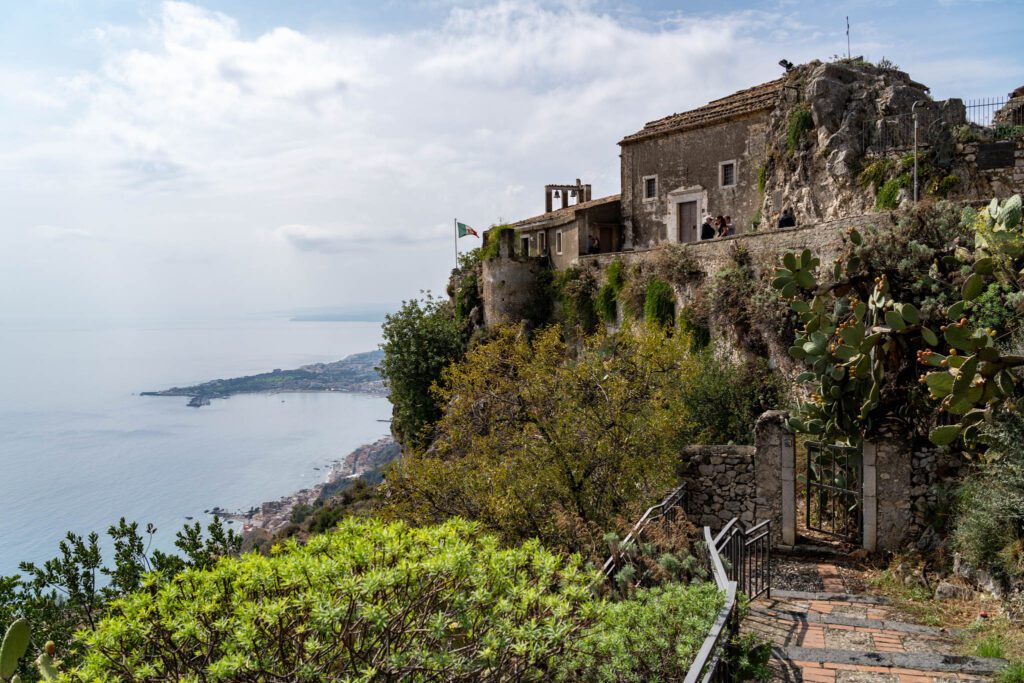
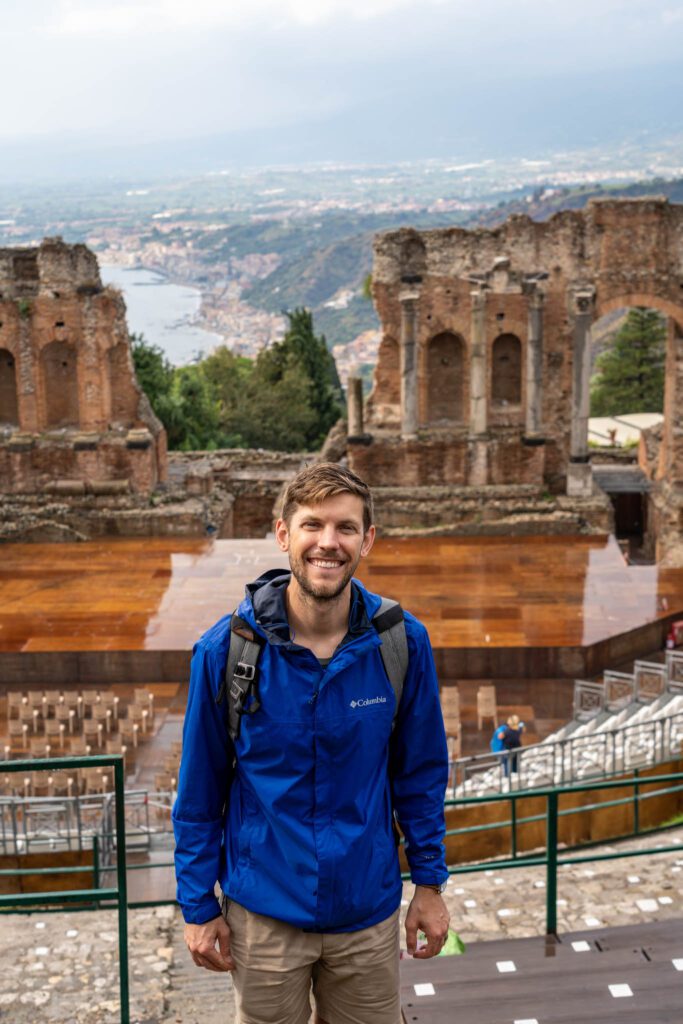

Visit the Fish Market (it’s NOT Just Fish!)

The Catania fish market – La Pescheria – is not to be missed while you’re in the city. It’s pure unadulterated chaos and the energy is palpable. We were lucky to be situated in an apartment right above the famous Catania fish market, which meant a faintly fishy smell drifted into the place anytime you opened a window before noon.
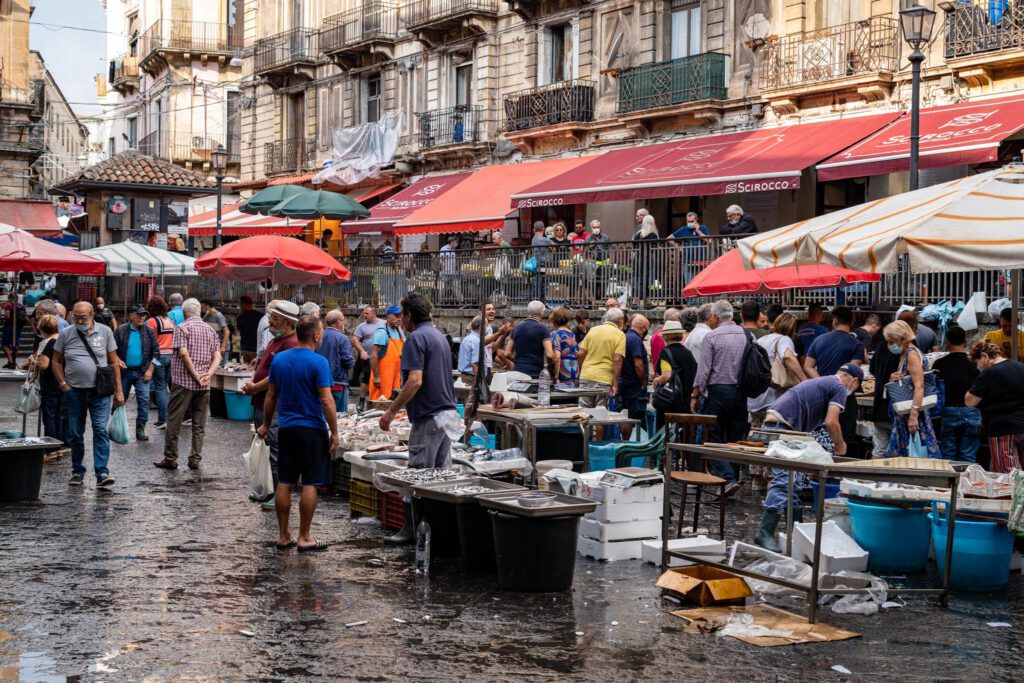
The market is about far more than fish – there are some great vegetable stands, along with butchers, cheesemongers, and more – but the most interesting part is certainly the different types of seafood in various states of butchering. From disembodied swordfish heads to still-twitching shrimp, the market is swarmed with people in the early morning.
Seafood is a huge component in Sicilian cuisine, which makes total sense given the fact that most of the island is within a short drive of the Mediterranean Sea.
The market takes place just off of Piazza del Duomo, and as we walked through the arch from the central piazza, we went into a state of sensory overload that only abated when we left the market.
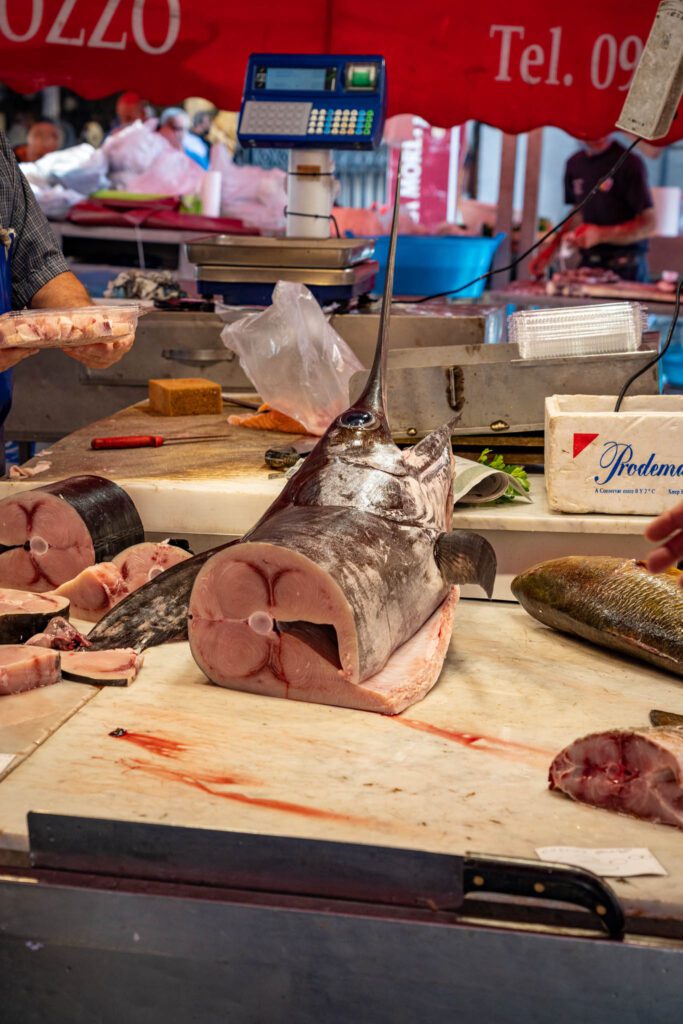

The smell of fresh fish and saltwater. The vague feeling that you’re walking through a mix of fish guts and water. The sight of a disembodied swordfish or a giant squid. The sound of splashing water as vendors try to keep their shellfish fresh. The various vendors all yelling and competing for the attention of visitors. Or the sound of intense negotiations in Italian over the price of a kilo of eggplant.
It’s A LOT. But it’s a slice of local life that you won’t want to miss in Catania.
Try Pasta alla Norma
If you don’t already know this, I have Celiac Disease, which means I need to be super careful about eating completely gluten free, including cross-contamination. Which can be hard in terms of food experiences while traveling, and sometimes means I miss out on trying local delicacies when we can’t find a reliable gluten free option.
Immediately before Sicily, we were in Paris and I was joking with someone I met that, while there are plenty of gluten free restaurants in Paris, none of them actually serve French cuisine.
In Sicily, we’d heard so much about the amazing food from people around us that I was determined not to miss out.

The first thing we knew we needed to try was pasta alla norma, a traditional Sicilian pasta dish that consists of eggplant, pasta (duh), tomatoes, basil, and ricotta salata. Which, contrary to our previous beliefs, is a hard cheese (not the soft ricotta you usually find) and is salty and delicious.
So, we made it. Using this recipe. Was it completely authentic? Probably not, because we made it ourselves. But it was a lovely exercise in going to the local market for produce, the supermarket for cheese and pasta, and making it in our apartment in Catania.
However, statistics say that you probably don’t have Celiac Disease, so you will be able to try it cooked by a Sicilian rather than two amateur home chefs (lucky you!). Head to either A Putia Dell’Ostello (which we heard good things about from our Etna guide who recommended it), Trattoria Giglio Rosso, or La Pentolaccia (whose courtyard looks pretty amazing).
Learn About World War 2 and Sicily at Museo Storico dello Sbarco
I wasn’t quite sure about this one, but we ended up with more than enough time in Catania, so we made the trek out to the industrial area near the train station that has been transformed into a mini museum complex to learn about the impact of World War 2 on Sicily.
Over the past year or two, I’ve read several great pieces of historical fiction set in Italy during World War 2 (my favorites have been Beneath a Scarlet Sky and From Sand and Ash), and have become enamored with seemingly ordinary people doing extraordinary things in a country that we don’t always think about in the context of the second world war.
Falling behind the western front and the landing at Normandy and the eastern front and Stangrad, the battle for Italy was one of the most consequential fronts in Europe and the war, more broadly speaking. But we rarely hear about it, at least in the United States.
This museum – the Museo Storico dello Sbarco in Sicilia 1943 – which is a few minutes away from Catania Centrale on the east side of town near the water, was surprisingly good.
From the multimedia exhibits – including a replica of a Sicilian town with a bomb shelter that shakes, simulating a bombing and an interactive map that shows the progress of the Allies in Sicily – to the stunning photography exhibit from Phil Stern, who was a soldier in the African and Italian theater and has a pretty incredible set of photographs on display. It chronicles the year of 1943 in the context of the war and its impact on Sicily, which took place entirely within that single year.
There’s one thing you should keep in mind – it’s almost entirely in Italian. Like, 75% of it is in Italian. If you don’t speak Italian – we don’t, though we speak Spanish and can piece some of it together – then you’re going to have a hard time understanding everything.
But I would not let that dissuade you from visiting, because the true impact of the museum is in the multimedia exhibits – the contemporary photos and videos – and the expansive collection of items from the war.
There are plenty of signs in English to give you a good idea of what you’re looking at, for the most part, especially when the United States or Britain is involved in the events that are being talked about.
Eat Pistachios in Some Form (or, Every Form)
When we were in Rome, we were at a restaurant casually chatting with the waiter after ordering a dish with pistachios in it, and I offhandedly asked him where the pistachios come from. Lazio (near Rome)? “Sicilia!” he said animatedly, and proceeded to tell us all about pistachios and how they can’t grow them in Lazio, but the best pistachios in the world are in Sicily.
Then, on our tour of the Benedictine Monastery in Catania, our guide mentioned that pistachios love the ash and minerals in the soil that come from Mount Etna.
Now, I don’t know how scientifically valid that really is, but it passes the sniff test enough for me. Sure enough, the best pistachios in the world are, in fact, found in Sicily. Specifically in Bronte, which is on the western slopes of Mount Etna.
You’re probably not making it out to Bronte, so while you’re in Catania, you should order something with pistachio in it. Especially between late August and late September, which is harvest time.
Some ideas for you:
- Granita di Pistacchio: Our favorite granita flavor is pistachio, which is a rich green color and usually has little chunks of nuts in it for a nice texture contrast. You could also do pistachio gelato, though granita is more fun in the summer.
- Pasta with Pesto di Pistacchio: We’ve had some pretty incredible pistachio pesto during our time in Italy, and it’s an idea that we’ve taken to heart and will be making at home.
- Pasta or Pizza with Pistachio Cream: Similar to pesto made with pistachios, but more rich and creamy. We’ve seen it as a pizza topping, or as a pasta sauce. It also comes in a sweeter version that’s kind of like Nutella, but make it pistachio (and take away the chocolate).
- Arancini di Pistacchio: Arancini, usually filled with melty cheese and pistachios, sometimes with some sort of cured meat.
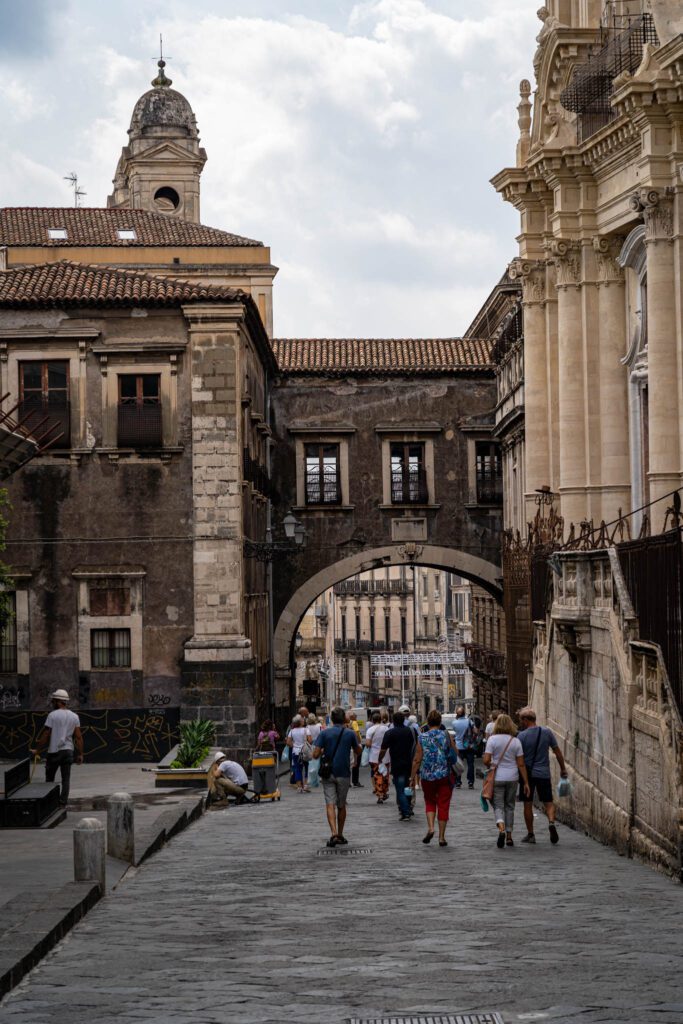

Logistics for Visiting Catania
Here are some logistics you’ll want to know to visit Catania.
How Many Days Do You Need in Catania?
We think either one or two nights is the perfect amount of time for exploring Catania itself, depending on how much time you have.
If you want to use it as a day trip to either Taormina or Mount Etna, add a day for each one.
You could also do Syracuse as a day trip, but we think it’s worth lingering there for a day or two, so we recommend staying in the charming adjacent city of Ortigia.
Where to Stay in Catania
We stayed right off of Piazza del Duomo – right over the fish market – and it was a phenomenal location in terms of centrality and walkability. Well worth the slightly fishy aroma drifting up from the street below in the mornings, when we were hanging out with the windows open.
In general, the area between Piazza del Duomo and Villa Bellini is the best place to stay in Catania. I’d avoid going more than two or three blocks east or west of Via Etnea, if you can.
I have Celiac Disease and need to eat strictly gluten free, so we need access to a kitchen to cook meals for ourselves. That generally means that we’re staying in apartments. The apartment we chose for Catania is this one – the deluxe apartment, specifically, which was HUGE.
Seriously, it may have been bigger than our old apartment in San Francisco. We should note that if we were to do it again, we’d choose the apartment with a terrace which is smaller, but has a nice view of the Duomo.
Here are some other options in the area that we’ve picked out from the many, many options out there based on style, value, and location:
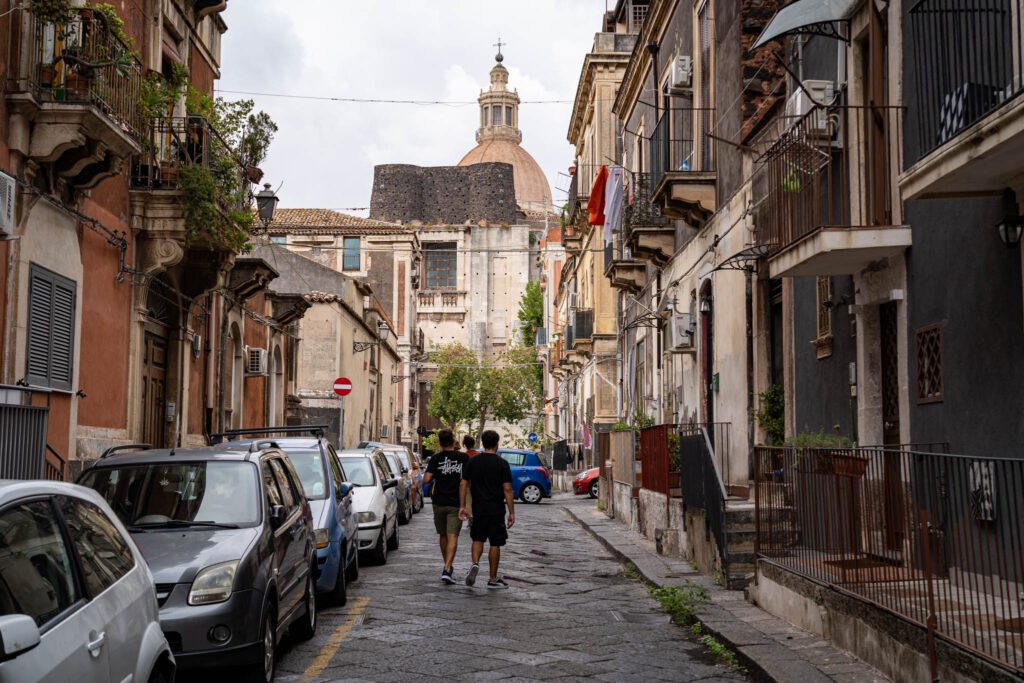
Getting from the Airport to Catania
Catania’s airport – Catania–Fontanarossa Airport – is just outside the city center, and is an easy bus ride into the city thanks to the handy ALIBUS (4 Euros, 20 minute journey). You meet the bus just outside of the arrivals area and baggage claim – follow the signs for ALIBUS. Tickets can be purchased from the driver onboard.
There are also connections from the airport to places like Syracuse and Taormina through bus companies like Interbus and Etna Trasporti.
Getting Around Catania
For the most part, you should be able to walk just about anywhere you need to go in Catania. The longest journey we took on foot was from Piazza del Duomo to the train station, which is about a 20 minute walk (1.5 km).
If you need to use the bus system, which we did a couple of times to get to the train station, then you’ll want to buy a ticket from a “tabacchi” in town BEFORE you get on the bus. They sell bus tickets, and they cost 1 Euro each. There are plenty of options around Catania’s center, it’s just a matter of finding one that’s open.
You might be able to buy a ticket on the bus from the attendant, who was there two out of the three times we rode the bus, but not always, which is why we recommend buying in advance at a tabacchi.
The most useful bus route is to the train station, and the best place to catch one from the area near Piazza del Duomo is at Piazza Borsellino, where there are multiple routes heading straight to Catania Centrale. The ride takes about 10 minutes, sometimes less.
